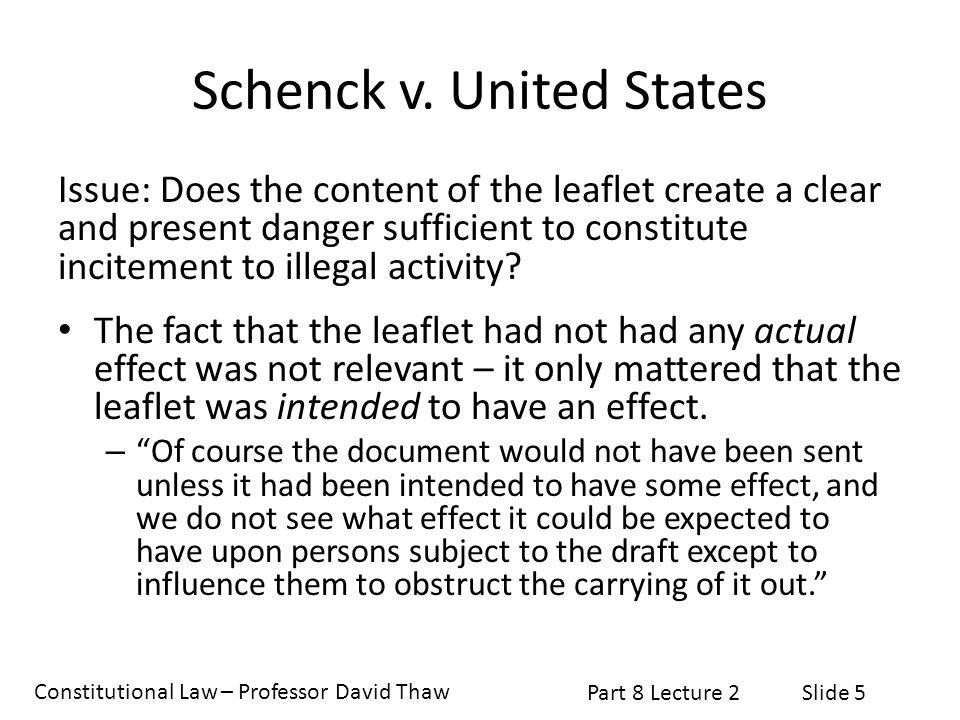Identify the Statements That Describe Schenck V. United States.
United States United States Supreme Court 1919 Case summary for Schenck v. United States 1919 Historical Background A major effort to promote national unity accompanied Americas involvement 1917-1918 in World War I.

Constitutional Law Part 8 First Amendment Freedom Of Expression Ppt Download
Decided by White Court.

. In 1929 the global financial system was based on the gold standard and extremely vunerable to any finanical downturn escalationg wuickly to catastrophic economic melthdown. Speaking for the Court Justice Oliver Wendell Holmes declared that the First Amendment did not prevent Congress from prohibiting speech. Citation 249 US 47 1919 Argued.
Schenck established a test to determine when free speech rights could be limited and brandenburg made the test stricter. New York Times Co. United States was a 1971 Supreme Court case concerning freedom of the press.
Supreme Court unanimously upheld enforcement of the Espionage Act of 1917 during World War I. United States 249 US. Appellant Charles Schenck.
Whoever when the United States is at war shall willfully make or convey false reports of false statements with intent to interfere with the operation or success of the military shall willfully cause or attempt to cause insubordination disloyalty mutiny refusal of duty or shall willfully obstruct the recruiting or enlistment service of the United States shall be. Lower court Federal district court. Schenck v United States Introduces the Clear and Present Danger Standard.
The question in every case is whether the words used are used in such circumstances and are of such a nature as to create a clear and present danger that they will bring about the substantive evils that. January 9 10 1919. The case is most well-known for Justice Oliver Wendell Holmes Jrs articulation of the clear and present danger standard.
47 1919 was a landmark decision of the US Supreme Court concerning enforcement of the Espionage Act of 1917 during World War IA unanimous Supreme Court in an opinion by Justice Oliver Wendell Holmes Jr concluded that defendants who distributed flyers to draft-age men urging resistance to induction could be convicted of an. United States legal case in which the US. Identify the type of interactions involved in each of the following processes taking place during the dissolution of sodium chloride nacl in water.
If youre seeing this message it means were having trouble loading external resources on. By causing and attempting to cause insubordination. Identify the statements that describe Schenck v.
Identify the statements that describe Schenck v. Justice Oliver Wendell Holmes Jr. Appellee United States.
Delivered the classic statement of the clear and present danger test in Schenck v. Following is the case brief for Schenck v. The circulars claimed that the draft was a monstrosity and that the draftees should stand up against it.
Background Schenck during WWI mailed circulars to draftees. In Schenck v United States 249 US. United States 1919 APGOPO.
In 1919 the Court upheld the constitutionality of the Espionage Act and the conviction of Charles T. LOR2C LO LOR2C3 EK Google Classroom Facebook Twitter. Supreme Court ruled on March 3 1919 that the freedom of speech protection afforded in the US.
Schench v US 1. In the military and naval forces of the United States and. The case upheld the constitutionality of the wartime Esponage Act.
The Background of Schenck v. The opinion begins with the Court first addressing the three counts against Schenk who was described as illegally printing and distributing the pamphlets by mail thereby participating in a conspiracy to violate the Espionage Act of June 15 1917. 47 1919 the US.
Words that create a clear and present danger that they. A self-proclaimed member of the Socialist Party Schenck disbursed almost 20000 leaflets urging the recipients to refuse to. In response Schenck was indicted for violating the Espionage Act the Act which made it a crime to.
United States established new standard for judging which dangerous speech could be restricted. In 1917 Congress passed the. Jan 9 - 10 1919.
Schenck placed limits on political speech during wartime and brandenburg expanded the limits to include. Evidence held sufficient to connect the defendants with the mailing of printed circulars in pursuance of a conspiracy to obstruct the recruiting and enlistment service contrary to the Espionage Act of June 15 1917. Schenck mailed out circulars criticizing draft supporters and informing draftees of their rights to oppose.
Charles Schenck was a socialist arrested for violating the Espionage Act by distributing pamphlets urging draftees to refuse to serve in World War I. Schenck a socialist who had distributed antidraft leaflets through the mails. Up to 24 cash back Schenck v.
Schenck set limits on symbolic speech for public school students and brandenburg applied the limits to citizens of all ages. Supreme Court in Schenck v. But he only advised peaceful action against the draft.
United States 1919 This is the currently selected item. As a part of this effort Congress enacted a number of laws severely restricting 1st Amendment freedoms to curb antiwar dissent. Constitutions First Amendment could be restricted if the words spoken or printed represented to society a clear and present danger.
Interactions between the ions of sodium chlorideb. United States 1919 Charles Schenck was arrested in 1919 subsequent to his organization of a protest against the draft undertaken by the Federal government of the United States in the wake of World War I. Location District Court for the Eastern District of Pennsylvania.

The Quotation Below Is From Schenck V United States A Famous Supreme Court Decision The Most Brainly Com
Comments
Post a Comment